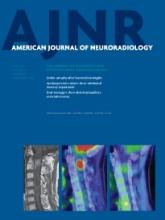Research ArticleFunctional
Open Access
Functional Homotopic Changes in Multiple Sclerosis with Resting-State Functional MR Imaging
Y. Zhou, M. Milham, X.-N. Zuo, C. Kelly, H. Jaggi, J. Herbert, R.I. Grossman and Y. Ge
American Journal of Neuroradiology June 2013, 34 (6) 1180-1187; DOI: https://doi.org/10.3174/ajnr.A3386
Y. Zhou
aFrom the Radiology/Center for Biomedical Imaging (Y.Z., H.J., J.H., R.I.G., Y.G.)
M. Milham
bNew York University Child Study Center (M.M., X.-N.Z., C.K.), New York University School of Medicine, New York, New York
X.-N. Zuo
bNew York University Child Study Center (M.M., X.-N.Z., C.K.), New York University School of Medicine, New York, New York
cLaboratory for Functional Connectome and Development (X.-N.Z.), Key Laboratory of Behavioral Science, Magnetic Resonance Imaging Research Center, Institute of Psychology, Chinese Academy of Sciences, Beijing, China.
C. Kelly
bNew York University Child Study Center (M.M., X.-N.Z., C.K.), New York University School of Medicine, New York, New York
H. Jaggi
aFrom the Radiology/Center for Biomedical Imaging (Y.Z., H.J., J.H., R.I.G., Y.G.)
J. Herbert
aFrom the Radiology/Center for Biomedical Imaging (Y.Z., H.J., J.H., R.I.G., Y.G.)
R.I. Grossman
aFrom the Radiology/Center for Biomedical Imaging (Y.Z., H.J., J.H., R.I.G., Y.G.)
Y. Ge
aFrom the Radiology/Center for Biomedical Imaging (Y.Z., H.J., J.H., R.I.G., Y.G.)

REFERENCES
- 1.↵
- Stark DE,
- Margulies DS,
- Shehzad ZE,
- et al
- 2.↵
- Zuo XN,
- Kelly C,
- Di Martino A,
- et al
- 3.↵
- Fair DA,
- Dosenbach NU,
- Church JA,
- et al
- 4.↵
- Kelly C,
- Zuo XN,
- Gotimer K,
- et al
- 5.↵
- Brown LN,
- Zhang Y,
- Mitchell JR,
- et al
- 6.↵
- Ge Y,
- Law M,
- Johnson G,
- et al
- 7.↵
- 8.↵
- Aboitiz F,
- Montiel J
- 9.↵
- Kennerley SW,
- Diedrichsen J,
- Hazeltine E,
- et al
- 10.↵
- 11.↵
- Ge Y,
- Law M,
- Grossman RI
- 12.↵
- Chao YP,
- Cho KH,
- Yeh CH,
- et al
- 13.↵
- Lowe MJ,
- Beall EB,
- Sakaie KE,
- et al
- 14.↵
- Rocca MA,
- Absinta M,
- Moiola L,
- et al
- 15.↵
- 16.↵
- 17.↵
- Zuo XN,
- Kelly C,
- Adelstein JS,
- et al
- 18.↵
- Power JD,
- Barnes KA,
- Snyder AZ,
- et al
- 19.↵
- Mesulam M
- 20.↵
- Smith SM,
- Jenkinson M,
- Johansen-Berg H,
- et al
- 21.↵
- Rosas HD,
- Lee SY,
- Bender AC,
- et al
- 22.↵
- Lazar M,
- Weinstein DM,
- Tsuruda JS,
- et al
- 23.↵
- Mori S,
- van Zijl PC
- 24.↵
- Tyszka JM,
- Kennedy DP,
- Adolphs R,
- et al
- 25.↵
- Lenzi D,
- Conte A,
- Mainero C,
- et al
- 26.↵
- Johnston JM,
- Vaishnavi SN,
- Smyth MD,
- et al
- 27.↵
- 28.↵
- Cifelli A,
- Matthews PM
- 29.↵
- 30.↵
- Evangelou N,
- Konz D,
- Esiri MM,
- et al
In this issue
Advertisement
Y. Zhou, M. Milham, X.-N. Zuo, C. Kelly, H. Jaggi, J. Herbert, R.I. Grossman, Y. Ge
Functional Homotopic Changes in Multiple Sclerosis with Resting-State Functional MR Imaging
American Journal of Neuroradiology Jun 2013, 34 (6) 1180-1187; DOI: 10.3174/ajnr.A3386
0 Responses
Jump to section
Related Articles
- No related articles found.
Cited By...
This article has not yet been cited by articles in journals that are participating in Crossref Cited-by Linking.
More in this TOC Section
Similar Articles
Advertisement











